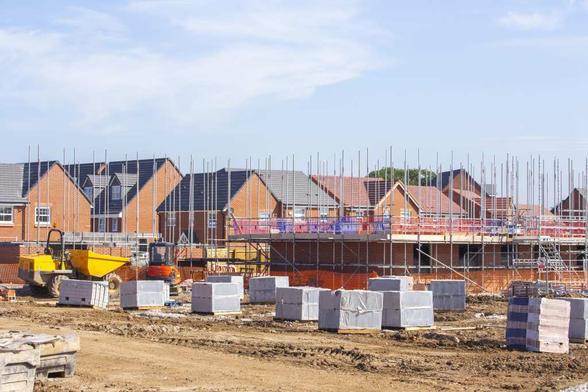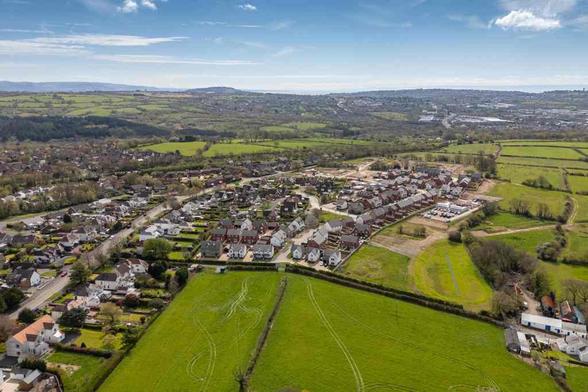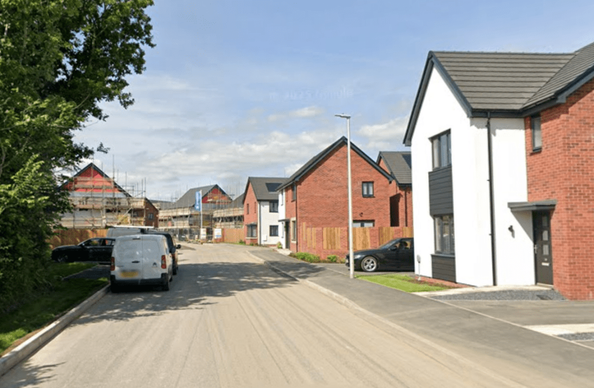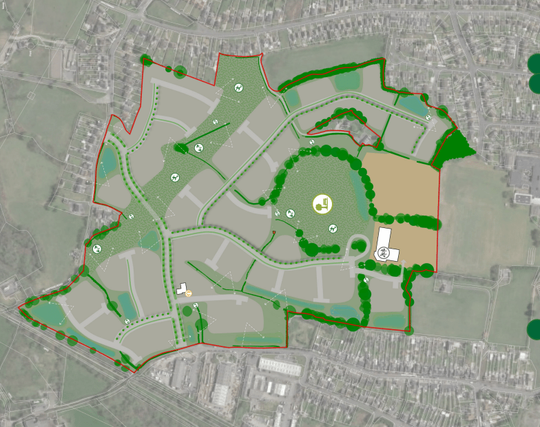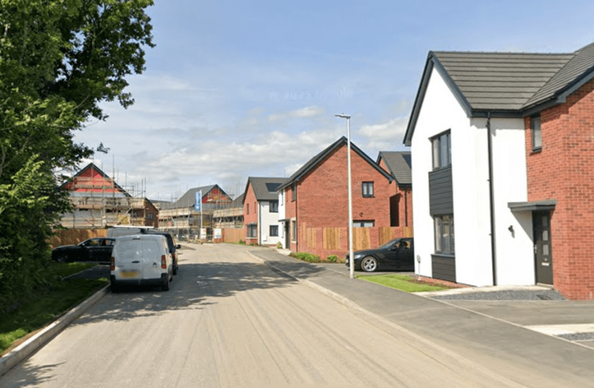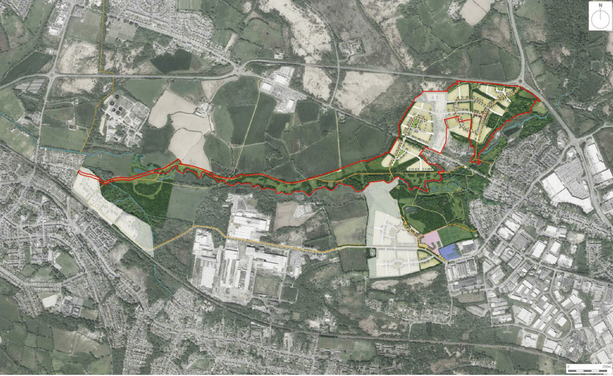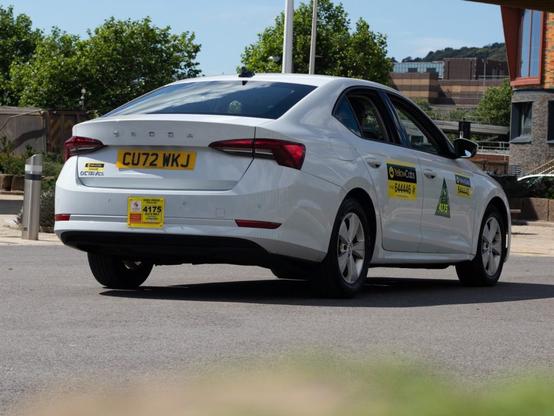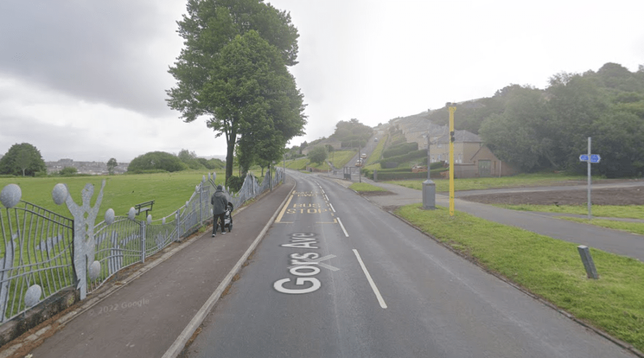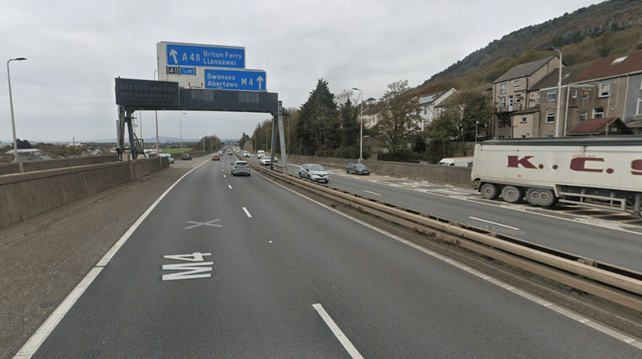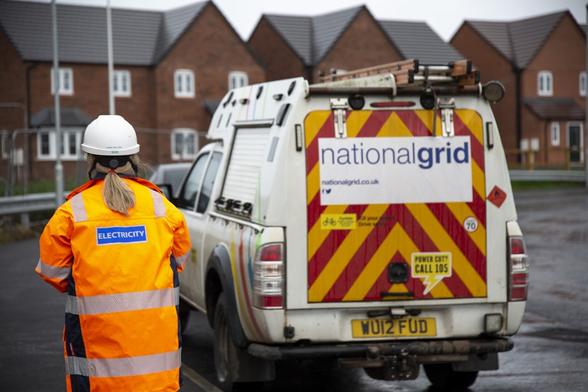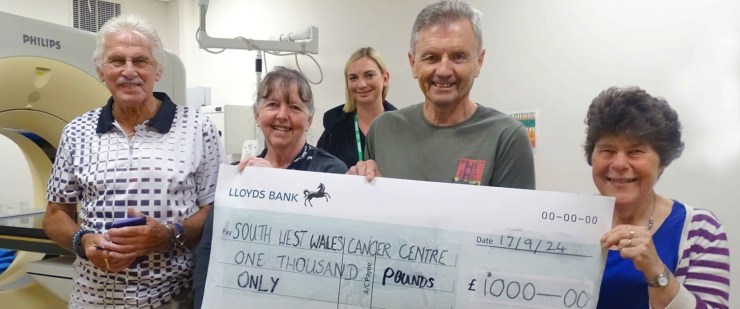7,000 homes promised, just 300 built: Swansea’s housing blueprint falters
What this feature covers
- The 7,000 homes promised in Swansea’s Local Development Plan – and why fewer than 300 have been built
- A site‑by‑site look at the Strategic Development Areas: from Penllergaer to St Thomas
- The obstacles – from Covid and costs to nutrient neutrality rules
- The impact on families, communities and local services
- How the next Local Development Plan (LDP2) could reshape Swansea’s growth to 2038
When Swansea councillors adopted the Local Development Plan (LDP) in 2019, it was meant to be a clear guide for growth. Instead of scattered estates, the council wanted builders to focus on a dozen large “Strategic Development Areas” (SDAs) — planned new neighbourhoods with schools, shops, roads and green space. The promise was bold: more than 7,000 homes within five years. Six years later, the council’s own Annual Monitoring Report shows fewer than 300 have been built.
At the latest planning committee, Cllr Peter Black voiced frustration:
“It does seem as if the plan is aiming to be a planned economy without actually any control over the economy. We’re saying how many houses we want built without having any control over that.”
Responding, Tom Evans, the council’s Placemaking and Strategic Planning Manager, acknowledged the difficulties, stressing that Swansea is not alone:
“Deliverability of residential sites has been one of the biggest difficulties we’ve experienced — and it’s not limited to Swansea, it’s a national issue.”
The Strategic Development Sites
Parc Mawr, Penllergaer (planned: 644 homes | delivered: 119)
Drone photography at Bellway’s Parc Mawr developmentBellway Homes is building here, and aerial photos show rows of new houses already occupied. But Parc Mawr has been one of the most controversial sites. A vocal campaign group, Preserve Penllergaer, fought the allocation from the start, warning that the promised primary school and relief road might never materialise. Penllergaer Community Council has echoed those concerns, arguing the development risks overwhelming local services. The late Cllr Wendy Fitzgerald was a prominent critic, warning in 2020 that the scheme would “change the character of the village forever.”
Garden Village, Gorseinon (planned: 700 homes | delivered: 24)
Google Maps view showing Persimmon’s Garden Village development near Gorseinon under construction, where more than 700 new homes and a primary school are being built.Garden Village has history: it was first conceived as a model community in the early 20th century, but World War I halted progress. A century later, Persimmon was tasked with reviving the idea. Yet only 24 homes have been built so far. The site has been dogged by concerns over ancient woodland, which led to a public inquiry, and by scepticism that the “garden village” branding masks a conventional estate. For now, the grand vision remains largely on paper.
Pontarddulais (planned in the LDP: 486 homes | delivered: 0)
Persimmon’s Pontarddulais MasterplanOn paper, Pontarddulais was supposed to take around 486 homes under the Local Development Plan. In reality, the schemes now on the table go well beyond that figure — and the town has become one of the fiercest battlegrounds in Swansea’s housing debate.
Persimmon’s zero‑carbon neighbourhood
The biggest proposal is from Persimmon Homes, which has branded its 280‑acre scheme south of Glanffrwd Road as a “zero‑carbon ready” neighbourhood. The plans, lodged in 2024, set out 516 homes powered by air‑source heat pumps and solar panels, with no gas connections at all. Persimmon promise a new primary school, a community hall, parks, play areas and sports pitches, alongside contributions for a 3G pitch at Pontarddulais Comprehensive and upgrades to local bus services.
Supporters say it would bring jobs and give young families a chance to stay in the town. But opponents point to the same pinch‑points that have dogged every major application here: traffic through St Teilo Street, the Station Road/Water Street junction, and the pressure on schools and GPs. Councillors resolved to approve the scheme in March 2025 “despite traffic and infrastructure concerns,” but as of this autumn, the fields remain untouched.
Walters’ aluminium site and the spine road row
A second scheme is also moving forward on the former aluminium factory site off Station Road, promoted by Walters Land Ltd. Outline consent has been granted for up to 150 homes, part of a wider tract of land that could eventually deliver as many as 720. The plan has been mired in rows over the so‑called “spine street” — a relief road meant to take traffic away from Water Street. The original LDP envisaged a western route parallel to the railway, but flood risk has forced Walters to propose a new alignment via High Street and Woodville Street. Residents fear it will funnel HGVs and commuter traffic through residential streets.
Even councillors have voiced unease. Cllr Phil Downing warned at committee: “It’s either going to be a functional road, or it’s not – in which case what are we doing?” Despite those misgivings, the outline plans were approved, with just 10% affordable housing promised because of abnormal remediation costs. Walters intend to clean up the site and then sell it on to a housebuilder for detailed consent.
For now, Pontarddulais remains in limbo: two major schemes approved in principle, more homes than the LDP ever envisaged, but not a single brick laid. To campaigners, it’s proof the town is being asked to take too much. To developers, it’s a chance to deliver “sustainable, future‑proof” neighbourhoods. To residents, it’s years of uncertainty with no clear end in sight.
Both major schemes also fall within the nutrient neutrality catchment, meaning even with outline approvals, progress could be delayed until developers can prove their plans will not add to pollution in the Burry Inlet.
Morriston, Clasemont Road (planned: 490–600 homes | delivered: 0)
The Pantlasau Farm development site off Clasemont Road.(Image: Mitchell, Eley, Gould)The land north of Clasemont Road, known as Pantlasau Farm, was one of the flagship allocations in the Local Development Plan. A detailed “Design Code” was drawn up in 2017 by consultants Mitchell Eley Gould on behalf of the Morris Estate Trustees, setting out a vision for up to 600 homes.
The plans imagined a high‑density, walkable neighbourhood inspired by the original 18th‑century Morriston grid. Key features included:
- A new primary school and playing fields.
- A local centre with shops, community space and a small commercial hub.
- A network of green corridors and a nature reserve to buffer the site from the M4.
- A mix of houses and flats, with higher densities around the centre and lower densities at the edges.
- Play areas and sports facilities (one multi‑use games area, three larger play areas and nine smaller ones).
- A street layout designed as “shared spaces” to slow traffic and prioritise walking and cycling.
The 26‑hectare site was to be built in phases over a decade, starting with around 100 homes and a small commercial space, before expanding to include the school and community hub.
A masterplan on paper
Yet despite the detailed framework, no homes have been built. The allocation remains on paper, a reminder that even with masterplans and design codes, delivery depends on developer appetite, infrastructure funding and market conditions.
Llangyfelach, M4 Junction 46 (planned: 565 homes in the LDP | live proposals: up to 1,950 | delivered: 0)
Llanmor homes is behind plans for 1,950 new homes on 280 acres of land off Llangyfelach Road (Image: Google Maps)From 565 to 1,950 homes
At the northern edge of Swansea, just off Junction 46 of the M4, lies one of the most ambitious housing sites in the Local Development Plan. Known as Pentref Rhostir, the 280‑acre tract of farmland was originally allocated for 565 homes. Since then, developer Llanmoor Homes has secured outline consent for a far larger scheme: a new community of up to 1,950 homes to be built over 15–20 years, with around 15% affordable.
The masterplan promises more than just housing. It includes:
- A new primary school.
- A local centre with shops, food outlets, medical and community facilities.
- A 1.4km link road designed to ease congestion on Llangyfelach Road.
- Around 100 acres of public open space, with sports pitches, play areas and landscaped green corridors.
- Contributions to active travel routes, ecology improvements, and an on‑site demand‑responsive bus service.
Outline consent, no spades in the ground
The first phase was expected to deliver 472 homes, with Llanmoor previously aiming to start infrastructure works in spring 2025 and open a sales centre by autumn. But as of autumn 2025, the fields remain untouched. Despite outline consent and glossy brochures, not a single home has yet been built.
For supporters, Pentref Rhostir is a chance to deliver the scale of housing Swansea desperately needs, in a location with space to grow. For critics, it is a symbol of the gap between the city’s housing promises and the reality on the ground — a flagship allocation still waiting to break ground.
Despite outline consent, the site lies within the affected catchment, so condition discharge and detailed applications may now face additional scrutiny under the new nutrient rules.
Penderi Regeneration
Drone view of Swansea Council’s Colliers Way development in Blaenymaes, where 36 new energy‑efficient council homes have been completed.(Image: Swansea Council)Penderi — the collective name for the communities of Blaenymaes, Portmead, Penplas and Cadle — is not a strategic LDP housing allocation but a neighbourhood regeneration programme. The area is dominated by social housing, with thousands of homes owned by Pobl and Swansea Council, and has long faced challenges of poor connectivity, deprivation and ageing housing stock.
Since the LDP was adopted, the most significant investment here has been in retrofitting existing homes rather than large‑scale new construction. The flagship Penderi Energy Project, led by Pobl in partnership with Sero, is one of the UK’s largest residential retrofit schemes. It is upgrading 644 social homes with solar panels, battery storage and other energy‑efficient technologies, aiming to cut bills and carbon emissions.
There has also been some new council housing: Swansea Council has completed 36 homes off Colliers Way in Blaenymaes — 18 built to ultra‑efficient Passive House standards and 18 to the council’s own “Swansea Standard,” which performs 25% better than building regulations.
The 2022 regeneration prospectus, prepared with The Urbanists, sets out a 15‑year vision for a 92‑hectare area. It proposes:
- Transforming The Ravine and other green corridors, with 27ha of landscape improvements overall.
- Upgrading 14ha of sports fields at Penlan Fields.
- Testing layouts for 384 new dwellings, potentially adding around 921 residents.
- Raising tree canopy cover from 7.5% to 50% within 15 years, through new street trees, fruit trees in gardens and extensive planting.
The ambition is to turn Penderi from a low‑density, service‑poor estate into a greener, healthier, better‑connected neighbourhood. Progress so far has been modest — a retrofit programme and a handful of new council homes — but the groundwork has been laid for a much larger transformation if the masterplan is realised.
Cefn Coed Hospital, Tycoch (planned: 371 homes | delivered: 73 pre‑LDP, 0 since)
Drone view of the derelict Cefn Coed Hospital site in Tycoch, with the 73‑home Bellway estate at Lon Masarn in the foreground. The health board now plans to keep part of the site for a new mental health unit, reducing the number of homes likely to be built.(Image: 28dayslater)The sprawling Cefn Coed Hospital site was originally earmarked for around 350–370 homes once services moved out. An early phase on the edge of the site, built by Bellway Homes off Lon Masarn, delivered 73 houses before the Local Development Plan was adopted.
But the wider redevelopment has stalled — and the scale of housing is now set to shrink. In 2023 Swansea Bay University Health Board confirmed that part of the land will be retained for a new adult acute mental health unit, with space for parking and possible future expansion. That means the number of homes likely to be built has fallen to around 170, almost half the original figure.
The health board has also acquired and plans to demolish an old Welsh Ambulance Service building on the site to make way for the new unit, subject to planning approval. Officials said the change reflects the need to modernise NHS facilities while managing a £100m+ maintenance backlog across the estate.
At the same time, the board has identified surplus land, including parts of Cefn Coed, as potential “candidate sites” for housing in Swansea Council’s next Local Development Plan (LDP2). That means some areas could still be released for development, but the final balance between health facilities and housing will only be confirmed in the new plan.
Waunarlwydd / Fforestfach (planned in the LDP: 716 homes | delivered: 0)
Red‑line boundary map of Barratt Homes’ proposed “Keepers Lodge” development at Waunarlwydd, showing the farm site off Titanium Road earmarked for around 400 homes, a primary school and a community hub.This corner of Swansea was earmarked in the Local Development Plan for major growth, with around 716 homes expected. In practice, the proposals now emerging are even bigger.
Persimmon’s ribbon of development
Persimmon’s outline for a 600‑home estate has already stirred fears of a “continuous ribbon” of development stretching from Penllergaer to Gowerton. Campaigners warn it would erode the green gaps between communities and overload the A484 corridor.
Barratt’s Keepers Lodge vision
And in late 2024, Barratt Homes began consulting on a second scheme at Keepers Lodge Farm, off Titanium Road. Their boards, shown at a pre‑application consultation in November 2024, set out a vision for around 400 homes, a new primary school, and a “community heart” with shops, commercial space and community facilities.
The boards also noted that the wider site is allocated in the LDP for mixed‑use development of approximately 1,319 homes — far more than the 716 figure usually quoted. Barratt’s “Keepers Lodge” would be the first phase of that larger allocation.
For now, though, the fields remain untouched. No formal planning application has yet been lodged, and residents are bracing for another round of arguments over traffic, schools and the loss of green space.
Gowerton, Fairwood Terrace (planned in the LDP: 664 homes | delivered: 0)
Planning map showing the red‑line boundary of the proposed 216‑home development off Fairwood Terrace, Gowerton. The scheme, refused by Swansea Council in 2024, is now the subject of an appeal by Persimmon Homes and Urban Style Land.A strategic site with zero delivery
This site has become a symbol of the contradictions at the heart of Swansea’s Local Development Plan. On paper, the land at the end of Fairwood Terrace was earmarked for hundreds of homes. But when the first major application came forward — a joint bid by Persimmon Homes West Wales and Urban Style Land Ltd — councillors turned it down, despite their own officers recommending approval.
The outline application, lodged in 2024, sought permission for up to 216 homes alongside some mixed‑use commercial space. The plans promised a blend of flats and houses from one to four bedrooms, with just over 10% affordable housing, plus new pedestrian crossings, an upgraded signal‑controlled junction at Fairwood Terrace and Victoria Road, and even a potential park‑and‑ride hub to serve Gowerton railway station.
Residents were unconvinced. A Facebook campaign group, “Save Gowerton From Gridlock,” mobilised hundreds of objections, warning that the extra traffic would overwhelm the already congested Fairwood Terrace/Victoria Road junction, where a low railway bridge and rugby club access already create bottlenecks. Others raised concerns about the loss of mature trees and green space, and about pressure on local schools and GP surgeries.
In September 2024, the planning committee narrowly voted to refuse the scheme, citing congestion and amenity impacts. Officers warned the refusal reasons were weak and would be hard to defend at appeal, but councillors stood firm.
The twist came in 2025, when the case went to appeal before Planning and Environment Decisions Wales (PEDW). Gowerton ward councillors Susan Jones and Dai Jenkins, who had opposed the scheme, initially agreed to defend the refusal. But they later stepped back, saying they wanted to represent their constituents’ views more freely outside the formal constraints of the planning process. Into the breach stepped Cllr Peter Black, who has taken on the role of defending the council’s decision at the hearing, supported by planning officers.
The developers, meanwhile, are pressing hard. Persimmon and Urban Style Land argue the scheme fits the Local Development Plan and meets pressing housing needs. They have even lodged a claim for costs, insisting there is an “overwhelming case” for approval. Nearly 600 local submissions have been made to PEDW, underlining the depth of feeling in the community.
For campaigners, the refusal was a victory for common sense. For developers, it is a test case of whether Swansea can deliver the homes its own plan says are needed. For the council, it has become an awkward standoff: a strategic allocation with zero delivery, a developer determined to push ahead, and a community that feels it has already reached breaking point.
The Fairwood Terrace appeal has already been postponed while Planning and Environment Decisions Wales (PEDW) seeks further evidence on nutrient impacts — underlining how the new rules are already slowing decisions.
⚖️ Gowerton at Appeal
The Fairwood Terrace site (216 homes, part of the Gowerton allocation) was refused by Swansea’s planning committee in 2024 on traffic grounds, despite officers recommending approval.
Planning officers warned the refusal reasons were “not particularly strong” and may be hard to defend at appeal.
After ward members stepped back, Cllr Peter Black was nominated to defend the decision at a Planning and Environment Decisions Wales (PEDW) hearing.
Developers Persimmon Homes and Urban Style Land argue the scheme complies with the LDP and would provide “much‑needed housing.”
Nearly 600 local submissions have been made to PEDW, alongside petitions and objections citing congestion and safety concerns.
The appeal has since been postponed while inspectors seek further evidence on nutrient impacts, showing how the new nutrient neutrality rules are already affecting live cases.
Central Area / Waterfront (planned: 856 homes | delivered: 128 so far, with more underway)
Drone view of Swansea’s SA1 Waterfront showing Beacon Cymru’s new housing development under construction on Kings Road, part of the city’s Central Area regeneration.(Image: Beacon Cymru)
The Central Area / Waterfront SDA covers Swansea city centre and the SA1 Waterfront. It was earmarked in the Local Development Plan for 856 homes, alongside new commercial and leisure space. Since adoption in 2019, only 128 homes have been completed, but several major schemes are now underway that could lift delivery closer to target.
City centre regeneration
City centre regeneration has been the most visible. The Copr Bay Arena and bridge opened in 2022 as Phase One of the Swansea Central project. Phase Two is now progressing, with the former St David’s Shopping Centre site earmarked for a new office and learning campus. The council’s flagship 71/72 The Kingsway office scheme is complete, providing space for around 600 jobs in the tech and digital sectors. Alongside this, upper floors of vacant commercial buildings on The Kingsway and High Street are being converted into apartments to bring more residents into the core.
The Civic Centre prize
The Civic Centre site on the seafront is the next big prize. Urban Splash unveiled a “sketchbook vision” in December 2024 to transform the 23‑acre site with 500–600 homes, ground‑floor cafes and bars, a hotel, and even a two‑storey aquarium. The scheme will only move forward once council services relocate to Y Storfa, a new public sector hub in the former BHS store on Oxford Street. Y Storfa is due to open in late 2025, housing the central library, West Glamorgan Archive Service, and a range of council and partner services.
SA1 Waterfront schemes
SA1 Waterfront remains a key housing location. Pobl’s Sidings development added new apartments soon after the LDP was adopted, and further schemes are now in train. Construction began in early 2025 on 43 affordable homes on Langdon Road, due for completion in 2027. In late 2024, Beacon Cymru (formerly Coastal Housing) started work on 104 social rent apartments with ground‑floor commercial space on Kings Road. In May 2025, the Welsh Government agreed to sell two further SA1 plots (D5B and D9B) to Pobl and Beacon Cymru for 69 more social homes.
The University of Wales Trinity Saint David is also expanding its footprint in SA1. Its Innovation Matrix — a facility to connect business and academia — launched in 2025, with further research and collaboration projects under discussion.
Taken together, these projects show the Central Area / Waterfront is finally beginning to deliver on its promise of a denser, more vibrant urban core. But while the commercial and cultural elements have advanced quickly, the housing element is still catching up. Council officers say the area remains a priority for affordable and mixed‑use growth, with brownfield redevelopment and conversions central to the strategy.
Fabian Way Corridor (planned: 525 homes | delivered: 60)
Drone view of Swansea University’s Bay Campus on Fabian Way, with its seafront setting and landmark academic buildings forming the eastern gateway into the city.Marketed in the Local Development Plan as Swansea’s “Innovation Corridor,” Fabian Way was supposed to deliver hundreds of homes alongside jobs, research facilities and new commercial space. To date, just 60 homes have been built, leaving the residential element far short of the 525 promised.
Instead, most of the activity has been around infrastructure and employment. Swansea University’s Bay Campus is now firmly established, Amazon’s distribution centre dominates the eastern end, and SA1 continues to grow with new university and residential blocks. But the corridor’s housing allocations remain largely untouched.
Transport first, housing later
Two linked transport schemes are now at the heart of the strategy. The Baldwin’s Bridge replacement would see the existing bridge over Baldwin’s Crescent rebuilt or upgraded, while a new Langdon Road connection would create a spine road through SA1, parallel to Fabian Way. Together, they are designed to ease congestion, improve access to the city centre, and provide safer walking and cycling routes for students and commuters. Swansea Council has already approved land acquisition south of Fabian Way at the docks, and Welsh Government funding is in place for feasibility and design. The project is listed as a priority in the regional transport plan.
Crucially, this is a joint scheme between Swansea Council and Neath Port Talbot Council, because the county boundary runs directly through the middle of the development zone — just west of the Bay Campus. That split jurisdiction has long complicated delivery, but both councils are now working together to unlock the corridor’s potential.
Another missing piece is the long‑promised Southern Access Road to Coed Darcy. Planned for more than a decade, it was intended to link the 4,000‑home “urban village” on the former BP refinery site directly to Fabian Way, relieving pressure on Jersey Marine and providing a dedicated public transport corridor. Sometimes referred to as “Ffordd Amazon Stage 2,” the road was identified in the 2010 Fabian Way Transport Assessment as essential early infrastructure. Yet only a short stub was ever built, ending abruptly. The full link has been repeatedly delayed by the slow pace of Coed Darcy itself and the engineering challenge of crossing the protected Crymlyn Bog. Neath Port Talbot Council now acknowledges the scheme “has not been developed,” and its future depends on whether the re‑scaled Coed Darcy plans finally move forward.
Other works are also reshaping the area. Neath Port Talbot Council has begun major drainage improvements on Fabian Way to tackle persistent flooding, supported by the Welsh Government’s Resilient Roads Fund. Plans are advancing to expand the Fabian Way park‑and‑ride into a “green transport hub”, potentially with hydrogen production and large‑scale EV charging. And within SA1 itself, new planning applications for apartments on Langdon Road show that piecemeal residential growth is still happening.
For now, though, the vision of a thriving mixed‑use corridor remains incomplete. The infrastructure projects may unlock development sites and improve connectivity, but the housing allocations are still waiting to be realised — a decade after they were first promised.
Tawe Riverside / St Thomas (planned: 258 homes | delivered: 0)
Overhead drone view of the former St Thomas railway station site on the east bank of the River Tawe, with Swansea’s waterfront district and city centre beyond. The land is earmarked for a new riverside neighbourhood led by Urban Splash and Lovell.(Image: Swansea Council)
On the east bank of the River Tawe, the St Thomas allocation was supposed to deliver 258 homes as part of a wider riverside regeneration. To date, not a single dwelling has been built. Instead, the area has become the focus of a broader transformation effort, backed by UK Government Levelling Up funding and a new masterplan led by Urban Splash.
Urban Splash and Lovell’s riverside vision
The St Thomas Riverside site, once home to a railway station and later left as a green corridor, is now the subject of detailed proposals by Urban Splash and Lovell. Their Stage 1 Project Plan sets out around 158 new homes, half of them affordable, alongside a riverside promenade, a new public square, and flexible commercial units. Stirling Prize‑winning architects AHMM are part of the design team, with plans for riverside townhouses, a six‑storey “marker” building, and a central garden street. The scheme promises to reconnect St Thomas with the river for the first time in 150 years, with potential for a new pedestrian and cycle bridge to the city centre.
Levelling Up heritage projects
At the same time, the Tawe Riverside Corridor Action Plan highlights the area’s role as a heritage destination. A £28m Levelling Up programme is funding restoration of the Hafod Morfa Copperworks, new pontoons on the river, and upgrades to Swansea Museum. Together, these projects aim to create jobs, attract visitors, and complete missing links in the riverside walkway and cycle network.
Council depot site in play
The council’s own landholdings are also in play. Swansea Council has confirmed plans to vacate its long‑standing Pipehouse Wharf depot, relocating operations to a new facility at the Enterprise Park. The riverside depot, currently used for waste and recycling vehicles, sits next to the St David’s student accommodation on Morfa Road. Officials say the site is expected to generate “significant interest” from potential purchasers once it is released, adding to the pool of land available for regeneration along the Tawe corridor. Coastal Housing previously explored a 150‑home scheme here, though those plans did not progress. With the depot now earmarked for disposal, the site is once again likely to attract developers as part of the city’s wider riverside transformation.
For residents, the promise is of a greener, better‑connected neighbourhood, with new homes, public spaces and heritage attractions. But as with so many of Swansea’s strategic sites, the vision remains on paper. Delivery will depend on overcoming viability challenges, securing infrastructure funding, and navigating new environmental rules such as nutrient neutrality.
📊 Strategic Sites at a Glance
Parc Mawr, Penllergaer
644 planned | 119 built
Garden Village, Gorseinon
700 planned | 24 built
Pontarddulais
486 planned | 0 built
Morriston, Clasemont Road
490–600 planned | 0 built
Cefn Coed Hospital, Tycoch
371 planned | 73 built (before the LDP, none since)
Waunarlwydd / Fforestfach
716 planned | 0 built
Gowerton, Fairwood Terrace
664 planned | 0 built
Llangyfelach, M4 J46
565 planned (LDP allocation) | 0 built
Central Area / Waterfront
856 planned | 128 built
Fabian Way Corridor
525 planned | 60 built
Tawe Riverside / St Thomas
258 planned | 0 built
Total promised: 6,575–6,685 | Total delivered: fewer than 300
Why Swansea’s big sites stalled
The council points to Covid shutdowns, labour shortages, rising material costs, and new rules on drainage and biodiversity. Developers say large, infrastructure‑heavy sites are harder to make viable quickly. Campaigners argue the allocations were unrealistic, too big, or in the wrong places. And Swansea is not alone: Cardiff, Newport, Bridgend and Neath Port Talbot have all reported housing shortfalls.
Evans told councillors the next plan will need to be more selective:
“All of those sites that are identified, whether for housing or employment, are being reviewed as part of the new plan. What we need to do is make sure we’re identifying the most sustainable and deliverable, most appropriate sites for the next 10 to 15 years.”
On top of these challenges, a new environmental constraint has emerged — one that could stall Swansea’s housing pipeline even further.
Environmental rules put housing targets at risk
New nutrient neutrality rules could delay major housing projects across Swansea for months, threatening the city’s ability to meet its housing targets.
Natural Resources Wales (NRW) has ruled that the Burry Inlet and Carmarthen Bay Estuary Special Area of Conservation is in an “unfavourable condition” due to excess nutrients. That means every new development in the catchment must now prove it will not add to pollution levels.
Ian Davies, the council’s development manager, told the planning committee:
“We have to be sure that the development is not adding to the nutrients that are entering the water course and therefore impacting adversely on water quality.”
He warned that while small schemes such as household extensions can be “screened out”, larger housing projects — from single dwellings to 500‑home estates — will be on hold unless developers can demonstrate nutrient neutrality.
“Some of the larger applications… are going to be on hold. My feeling is that’s likely to be months rather than weeks in resolving this, even longer potentially.”
The change affects some of Swansea’s biggest growth areas, including the Loughor Estuary and north‑west Swansea, where thousands of homes are allocated in the Local Development Plan.
Cllr Peter Black told the committee:
“This area is one of the biggest areas of new house building growth in Swansea… those bigger applications are going to be massively hit by this.”
Knock‑on effects for viability
Developers will be expected to fund mitigation measures, such as reed beds or land set aside for nutrient offsetting, secured for the lifetime of the development. Officers warned this could reduce the scope for Section 106 contributions, meaning fewer affordable homes or lower investment in schools and community facilities.
“You may see reports recommending approval but not at the sort of levels of policy requirements in terms of section 106 contributions,” Davies said.
Regional challenge, national task force
The rules apply equally to council‑led housing schemes, not just private developers. Swansea is now working with Welsh Government, NRW and neighbouring authorities through a new task force to find long‑term solutions.
Tom Evans, the council’s placemaking and strategic planning manager, stressed that Swansea is not being passive:
“We have a seat around the table at the Welsh Government task force… we are very closely involved in trying to find the solutions.”
Officials stressed the requirement is a matter of law under the Habitats Regulations, not optional guidance, and will shape how housing sites are brought forward in the next Local Development Plan.
What it means for people here
For families, it means fewer affordable homes and more bidding wars. For young people, it means being priced out or pushed further afield. For communities, it means the schools, GP surgeries and roads that were supposed to come with the big sites haven’t materialised, leaving existing services under strain. Instead, most of Swansea’s new homes are coming from smaller “windfall” sites like Cwmrhydyceirw Quarry and Hendrefoilan. They’ve delivered hundreds of homes, but without the infrastructure the SDAs were supposed to guarantee.
The road to LDP2
The council is now preparing a new Local Development Plan, known as LDP2, which will run to 2038. Officials say the lessons of the past five years will feed into it: why the strategic sites stalled, how to make development viable, and how to ensure infrastructure arrives alongside homes.
Evans added that continuing to monitor delivery will be important:
“Producing another monitoring report would help us see whether or not delivery has been significantly affected by these new constraints.”
The draft “Preferred Strategy” for LDP2 doesn’t re‑list the stalled strategic sites by name. Instead, all existing allocations are being reviewed — some may be carried forward, others dropped, and new ones added. More than a thousand “candidate sites” have been submitted by landowners and developers, but inclusion on the register doesn’t guarantee allocation. Only those judged sustainable and deliverable will make it into the next plan.
For campaigners in Penllergaer, Pontarddulais and Gowerton, it’s a chance to argue again that their communities cannot absorb the scale of development proposed. For those struggling to find a home, it’s a reminder that Swansea’s housing crisis is far from solved. The next plan will shape where the city grows for the next decade. The question is whether it can succeed where the last one has so clearly stumbled.
Officials have confirmed that nutrient neutrality will be a core test for candidate sites, with only those able to demonstrate mitigation likely to survive into the final plan.
🗂️ What is LDP2?
The new plan:
Swansea is replacing its current Local Development Plan with a new version, known as LDP2, which will run to 2038.
Preferred Strategy:
Published in late 2024, it sets the vision, growth level and broad approach for where new homes and jobs should go.
Candidate sites:
More than 1,000 pieces of land have been put forward by landowners and developers. These are not allocations — they are being assessed for suitability and deliverability.
Strategic sites under review:
The big sites from the current plan are being reassessed. Some may be carried forward, others dropped, and new ones added.
Timeline:
A detailed “Deposit Plan” with confirmed sites is due in 2026. Adoption of LDP2 is expected around 2027/28.
Environmental constraints such as nutrient neutrality will be central to which sites are judged “deliverable” in the new plan.
#AffordableHousing #BarrattHomes #BayCampus #Bellway #Blaenymaes #BurryInlet #Cadle #CefnCoedHospital #ClasemontRoad #CllrPeterBlack #CoedDarcy #construction #FabianWay #FairwoodTerrace #featured #Fforestfach #GardenVillage #Gorseinon #Gowerton #homepage #housingBlueprint #housingCrisis #KeepersLodgeFarm #LDP #LDP2 #Llangyfelach #LlanmoorHomes #LocalDevelopmentPlan #M4Junction46 #Morriston #newHomes #nutrientNeutrality #PantlasauFarm #ParcMawr #PenderiRegeneration #Penllergaer #Penplas #PentrefRhostir #PersimmonHomes #planning #Pontarddulais #Portmead #SA1 #StThomas #StrategicDevelopmentAreas #SwanseaCityCentre #SwanseaCouncil #SwanseaHousing #TaweRiverside #Tycoch #Waterfront #Waunarlwydd
